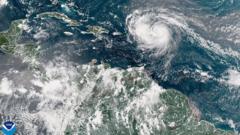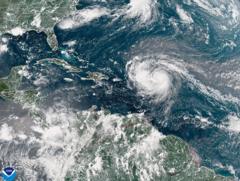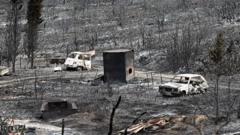Hurricane Erin has swiftly escalated into a powerful category five hurricane, bringing with it dangerous conditions and significant rainfall as it makes its way through the Atlantic.
Hurricane Erin Surges to Category Five Status: Impacts Anticipated for the East Coast

Hurricane Erin Surges to Category Five Status: Impacts Anticipated for the East Coast
Hurricane Erin is classified as a category five storm, with devastating winds and potential flooding for coastal regions.
Hurricane Erin has intensified dramatically, achieving category five status with maximum sustained winds of 160 mph (260 km/h). At a press briefing, National Hurricane Center Director Mike Brennan stated that the storm had "explosively deepened" overnight after transforming from tropical storm strength late last week. Expected to track north of the Leeward Islands, Virgin Islands, and Puerto Rico over the weekend, Erin is projected to bring as much as 6 inches (15 cm) of rainfall, raising concerns about flash floods and mudslides.
The storm, marking the onset of the 2025 Atlantic hurricane season, underwent rapid intensification, which is defined as a storm strengthening by at least 34 mph within a 24-hour span. Early Saturday, Erin's winds surged from 100 mph to a staggering 160 mph, according to Brennan.
Looking ahead, Erin is forecasted to continue moving northwards, passing to the east of the Bahamas and heading towards North Carolina’s Outer Banks next week. The hurricane is expected to generate perilous surf and rip currents along nearly the entire U.S. east coast over the upcoming days, with Florida and mid-Atlantic states likely to experience the most severe conditions. Bermuda could also face significant surf hazards and heavy rains.
Due to gale-force winds, the U.S. Coast Guard has enacted restrictions for vessels in several ports, including St. Thomas and St. John in the U.S. Virgin Islands, as well as in six municipalities across Puerto Rico, including San Juan. The National Oceanic and Atmospheric Administration (NOAA) has predicted an "above normal" hurricane season in the Atlantic this year, with an increase in the frequency of storms reaching category four and five, a trend attributed to climate change.




















